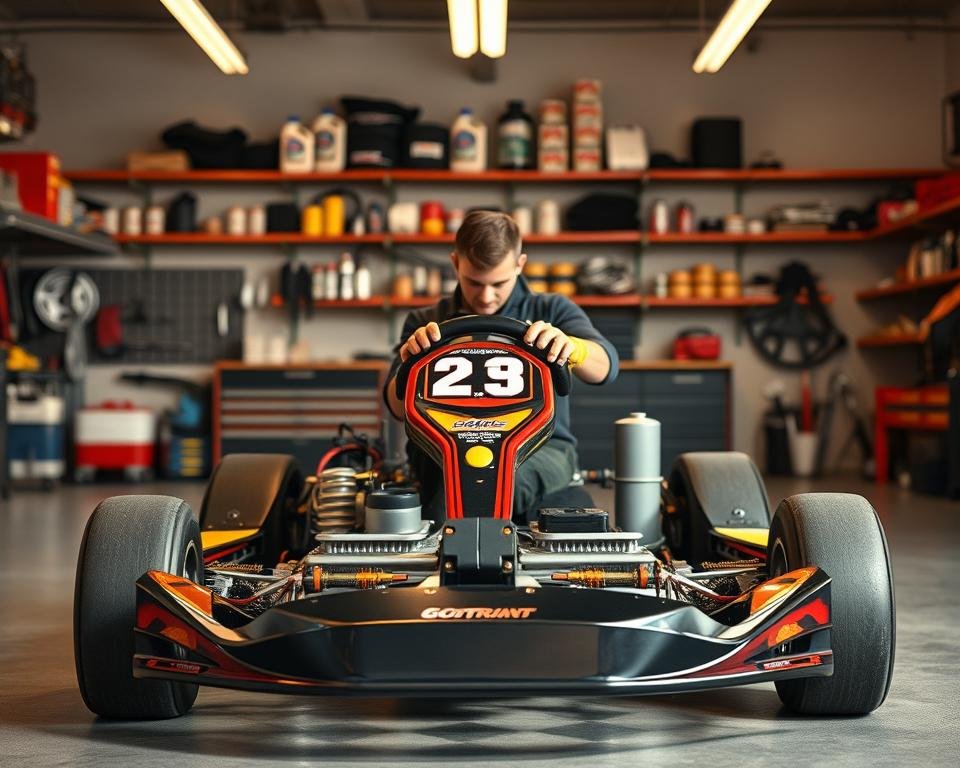Your go-kart isn’t just a toy—it’s a precision machine that thrives on care. Consistent upkeep boosts performance, safety, and longevity, whether you’re tearing up dirt tracks or cruising on weekends. Even 15 minutes of post-ride attention can prevent costly repairs down the line.
Think of your kart like a motorcycle: both demand respect for their mechanics. At Motobuys, we’ve crafted this guide for riders who value reliability. You’ll learn systematic routines that balance immediate cleaning with long-term engine care. These strategies work for casual enthusiasts and competitive racers alike.
From protecting metal parts against rust to keeping paint gleaming, the basics matter. Professionals stress that small efforts add up. A well-maintained machine delivers smoother rides and fewer surprises. Ready to dive deeper? Let’s explore the techniques that keep your kart in championship shape.
Understanding Your Go-Kart and Its Needs
Effective maintenance begins with component knowledge and manual insights. Your machine operates as a network of specialized parts working in harmony. Racing models and recreational karts have distinct requirements, especially when used in competitive categories with higher stress levels.
Know Your Kart’s Components
Start by learning critical systems: engine, brakes, steering, and drivetrain. Each part has unique wear patterns. Competition models generate extra heat, demanding frequent checks. Even karts designed for kids need thorough inspections—safety doesn’t scale down.
Identify daily vs. seasonal tasks. Chains loosen faster on dirt tracks. Belts stretch differently based on torque converters. Always check owner manual specifications before replacing components. Motobuys technicians recommend tracking service dates for bearings and axles.
Importance of the Owner’s Manual
This guide holds factory-approved intervals for oil changes and belt replacements. Manual specific details prevent guesswork—wrong fluids damage engines. Racing setups require shorter maintenance cycles, clearly outlined in your owner manual.
Keep the manual accessible. It lists exact part numbers and torque values. When buying belts or filters, check owner documentation first. This approach saves time and ensures compatibility across categories of use.
Pre-Maintenance Safety and Preparation
Safety drives every successful maintenance session. Whether prepping for track days or routine checks, smart preparation prevents accidents and ensures precise work. Start by gathering tools and reviewing your checklist—this mindset separates casual riders from serious enthusiasts.

Essential Safety Gear and Protective Equipment
Always wear nitrile gloves and ANSI-rated goggles. Chemical splashes and metal fragments pose real risks during maintenance. Opt for snug-fitting clothing—loose sleeves can snag on components. Closed-toe shoes protect feet if tools slip.
Setting Up a Suitable Workspace
Choose a flat, ventilated area with bright lighting. Position drip trays under the engine and transmission. Use jack stands rated for your kart’s weight—never rely solely on a floor jack. Keep fire extinguishers and absorbent mats nearby for spills.
Let the engine cool completely before inspections. Hot exhaust pipes distort fluid level readings and risk burns. Disconnect the battery terminals to eliminate electrical hazards. Track-ready standards begin here—every step impacts on-track reliability.
Basic Cleaning and Exterior Care
A spotless exterior isn’t just about looks—it’s your first defense against wear. Dirt and grime accelerate corrosion while masking potential issues. Smart cleaning preserves paint integrity and exposes hidden problems early.
Using the Right Cleaning Products
Start with pH-neutral automotive soap mixed with warm water. Harsh chemicals strip protective coatings, leaving metal parts vulnerable. For stubborn grease, apply WD-40 or specialized degreasers. Tru-Tension Bodywork Foam Cleaner lifts dirt without scrubbing.
Microfiber cloths prevent swirl marks better than cotton. Keep separate brushes for wheel wells and body panels to avoid cross-contamination. Dawn dish soap diluted in water tackles mud without damaging finishes.
Step-by-Step Exterior Cleaning Process
Rinse loose debris first using low-pressure water. Work top-to-bottom with soapy water, focusing on suspension areas and frame joints. A soft toothbrush cleans chain guards and bolt heads efficiently.
Dry immediately with waffle-weave microfiber to prevent water spots. Inspect bearings and bolts during cleaning—catching loose components early saves time and repair costs. Finish by treating metal parts with rust inhibitor.
Regular maintenance through proper cleaning keeps your kart race-ready. This routine doubles as a diagnostic tool, revealing wear patterns before they escalate.
Engine and Mechanical Systems Maintenance
A high-performance engine demands precise care to deliver peak power and reliability. Mechanical systems thrive on regular checks and quality fluids. Follow these protocols to avoid breakdowns and maximize track performance.
Routine Oil Changes and Air Filter Checks
Check oil levels monthly. Dark or gritty fluid signals it’s time to replace. Most manufacturers advise oil changes every 10-20 operating hours. Fresh lubricant reduces friction and prevents overheating.
Inspect the air filter during each oil change. Hold it against light—if particles block visibility, clean or replace it immediately. Clogged filters starve engines of air, cutting power output by up to 15%.
Spark Plug and Fuel System Inspection
Test spark plugs quarterly. Burnt electrodes or cracked porcelain require full replacement. Swap all plugs simultaneously for balanced combustion. This prevents misfires during acceleration.
Examine fuel lines and the fuel filter seasonally. Cracks in hoses risk leaks, while dirty filters restrict flow. Use a soft brush to clear debris from hard-to-reach connectors. Always consult your manual for filter locations.
Consistent maintenance preserves engine integrity. These steps take minutes but save hundreds in repairs. Track-ready performance starts with disciplined care.
Checking and Lubricating Key Components
Precision lubrication separates weekend riders from track champions. Moving parts demand strategic care to minimize friction and maximize performance. A disciplined approach here prevents mechanical failures during high-speed runs.
Chains, Bearings, and Axles Lubrication Techniques
Apply oil to chains link-by-link using a drip bottle. Let it penetrate rollers overnight before wiping excess. This prevents grime buildup while keeping movement smooth.
For bearings, use high-temp grease until fresh lubricant pushes out seals. Axles need coating where they meet metal parts and frames. Re-grease monthly if you ride on dirt tracks.
Tightening Bolts and Inspecting Belts and Chains
Check every bolt with a torque wrench before rides. Loose fasteners rattle apart under vibration—tighten spindles and brake calipers first. Replace worn belts showing cracks or fraying.
Inspect brake pads and rotors weekly. Measure thickness against your manual’s specs. Low tire pressure strains wheels and steering components. Keep psi within recommended ranges.
These steps take time but ensure your kart performs reliably. Consistent maintenance turns routine checks into competitive advantages.

